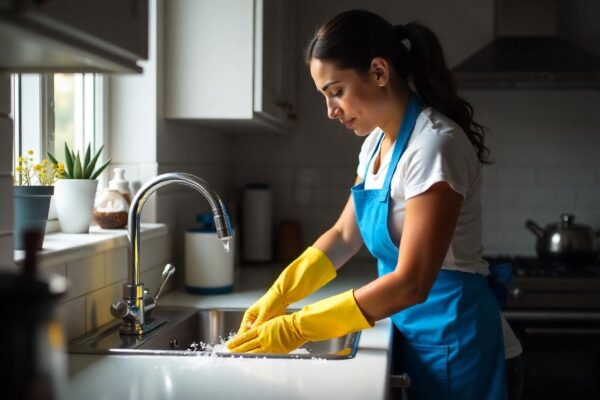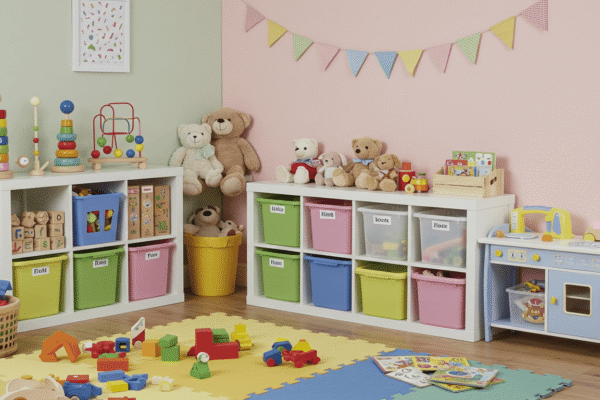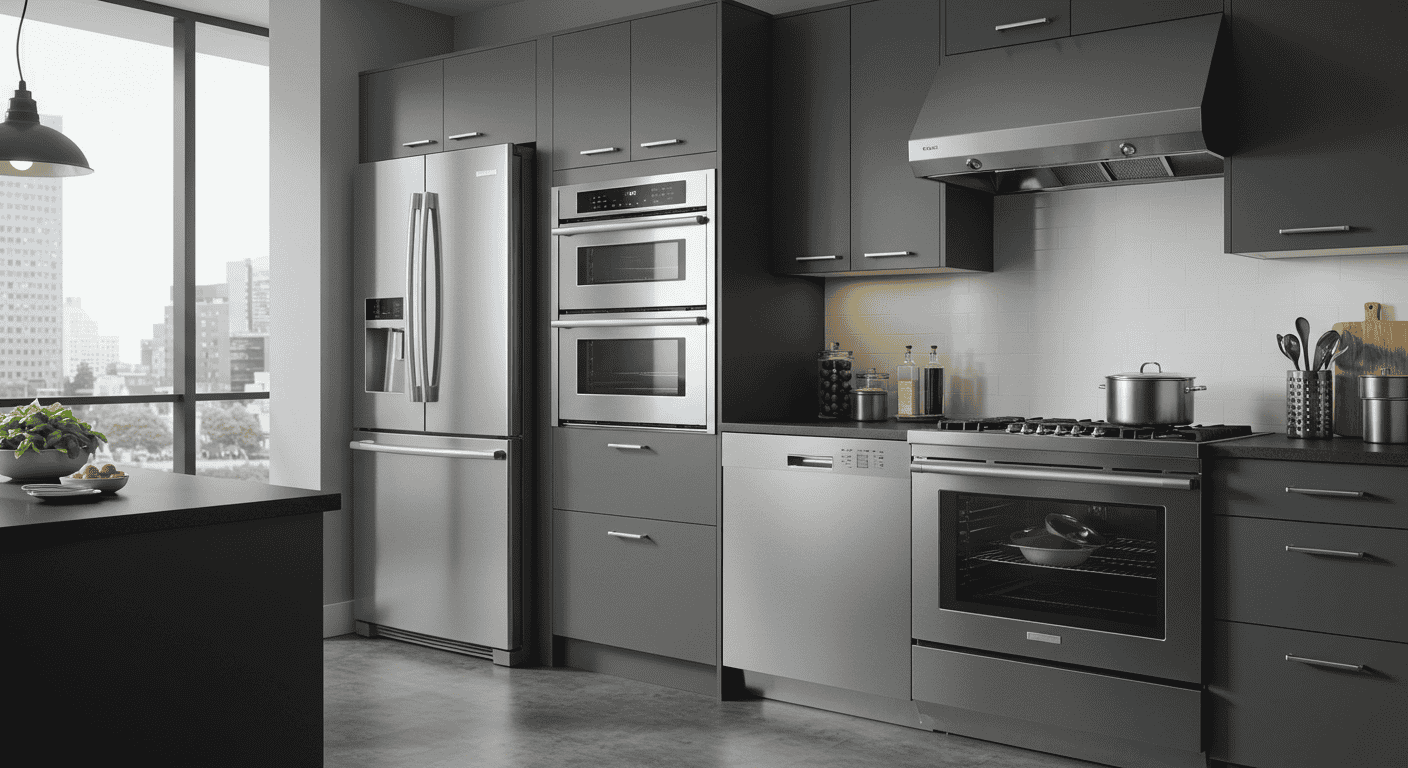Clean stainless steel appliances are a hallmark of a modern, sleek kitchen, but keeping them spotless can sometimes feel like a challenge. Whether it’s pesky fingerprints, stubborn smudges, or streaks, knowing the right techniques and tools makes all the difference. In this guide, you’ll discover easy, effective ways to clean stainless steel appliances using natural ingredients and simple methods that protect their finish and bring back that brilliant shine. Say goodbye to dull surfaces and hello to appliances that look brand new!
Why Proper Cleaning Matters for Stainless Steel Appliances
Keeping your stainless steel appliances clean is more than just a matter of appearance—it’s essential for preserving their quality and longevity. These appliances add a modern, polished look to any kitchen and are known for their durability. However, without proper care, the surface can become dull, scratched, or damaged over time. Understanding why proper cleaning matters helps you maintain that sleek, professional finish and protect your investment.
The Beauty and Benefits of Stainless Steel
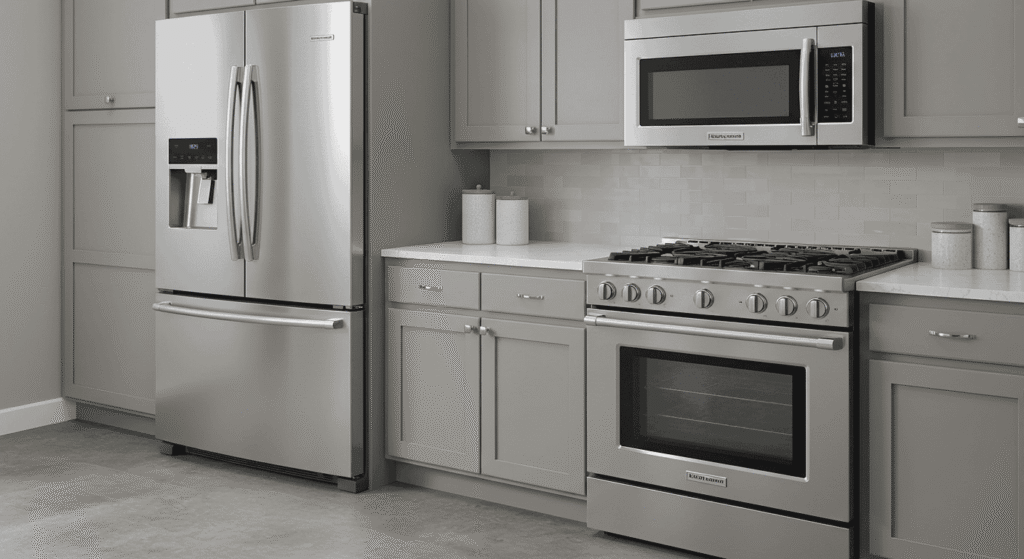
Stainless steel appliances are favored for several reasons. First, their durability makes them resistant to rust, corrosion, and heat, which is ideal for kitchen environments. Secondly, their sleek, reflective surface complements almost any kitchen design, adding a timeless, modern aesthetic that enhances your home’s value. Beyond looks, stainless steel is hygienic and easy to clean when cared for correctly. Proper maintenance ensures these appliances not only look good but continue to function well for years.
Common Problems: Fingerprints, Streaks, and Smudges
Despite their many benefits, stainless steel appliances are notorious for showing fingerprints, smudges, and streaks. These issues often arise from improper cleaning methods or using harsh chemicals that damage the surface. For example, wiping with abrasive materials can cause scratches, while using the wrong cleaners leaves behind streaks that dull the finish. Over time, these problems diminish the appliance’s appearance and can lead to permanent damage if ignored. Learning the right techniques to clean stainless steel is key to avoiding these common issues.
Quick Table: Common Stainless Steel Issues and Their Causes
| Issue | Cause | Effect on Appliance |
|---|---|---|
| Fingerprints | Natural oils and dirt | Visible smudges |
| Streaks | Harsh chemicals or improper wipe | Dull, uneven finish |
| Rust Spots | Exposure to moisture or scratches | Permanent discoloration |
This table highlights the most frequent challenges faced when cleaning stainless steel appliances. By identifying these issues and their causes, you can take the necessary steps to protect and restore your appliances effectively.
Essential Tools and Ingredients for Cleaning Stainless Steel Appliances
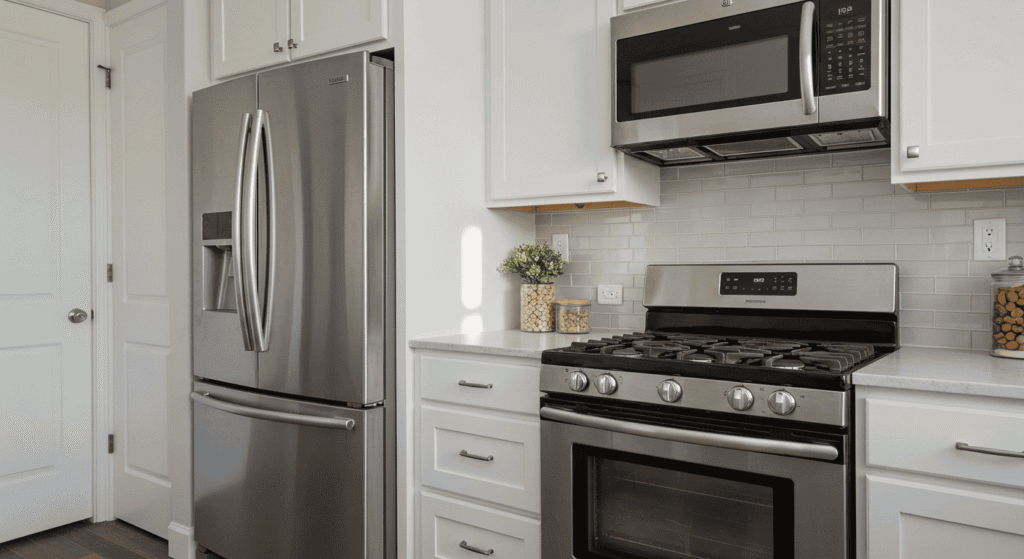
Having the right tools and ingredients makes all the difference when it comes to cleaning stainless steel appliances effectively. Using harsh or abrasive materials can damage the surface, so it’s important to choose supplies that protect while delivering a spotless finish.
Must-Have Tools for Effective Cleaning
To clean your stainless steel appliances without scratching or streaking, start with these essential tools:
- Microfiber cloths: These are soft, lint-free, and perfect for streak-free wiping.
- Soft sponges: Ideal for gentle scrubbing without damaging the surface.
- Gloves: Protect your hands when using cleaning solutions.
- Spray bottles: Useful for mixing and applying homemade cleaners evenly.
Natural Cleaning Ingredients You Can Find at Home
Many natural ingredients work wonders on stainless steel, offering an eco-friendly alternative to chemical cleaners:
- White vinegar: Excellent for cutting through fingerprints and grease.
- Baking soda: A gentle abrasive that helps remove stubborn spots.
- Lemon juice: Adds a fresh scent and helps dissolve grime.
- Olive oil: Perfect for polishing and restoring shine after cleaning.
Table: Cleaning Tools vs. Ingredients – When and How to Use Them
| Tool/Ingredient | Best For | Cleaning Tips |
|---|---|---|
| Microfiber Cloth | Streak-free wiping | Use dry or slightly damp |
| White Vinegar | Removing fingerprints | Dilute with water (1:1) |
| Baking Soda | Gentle scrubbing | Make a paste with water |
| Olive Oil | Polishing & protecting finish | Apply sparingly and buff well |
This table helps you understand when and how to use each tool or ingredient to get the best results while keeping your appliances safe.
Step-by-Step Guide: How to Clean Stainless Steel Appliances
Cleaning stainless steel appliances properly requires a careful approach to avoid damage and ensure a brilliant finish. Follow this step-by-step guide to achieve spotless, streak-free results every time.
Preparation: What to Do Before You Start
Before diving into cleaning, take a few preparatory steps:
- Remove any loose debris or crumbs from the appliance surface.
- Unplug appliances for safety, especially if cleaning areas near electrical components.
- Test your chosen cleaner on a small, inconspicuous spot to make sure it won’t harm or discolor the finish. This helps avoid surprises on the main surface.
Cleaning Process: The Right Way to Clean Without Damage
When you begin cleaning, keep these techniques in mind:
- Use gentle circular motions with a soft cloth or sponge to lift dirt without scratching.
- Always follow the grain direction of the stainless steel; wiping against the grain can cause visible streaks or scratches.
- Avoid over-wetting the surface; excess moisture can lead to water spots or rust.
- Dry the surface thoroughly with a clean microfiber cloth to prevent streaks and restore shine.
Finishing Touch: Polishing for a Streak-Free Shine
After cleaning, polishing is key to bringing out that signature shine:
- Apply a small amount of olive oil or a gentle polish to a soft cloth.
- Buff the appliance surface in the direction of the grain using light pressure.
- This step not only enhances the shine but also adds a protective layer to repel fingerprints and smudges.
By following these steps, your stainless steel appliances will look clean, fresh, and as good as new.
DIY Natural Recipes for Cleaning and Polishing
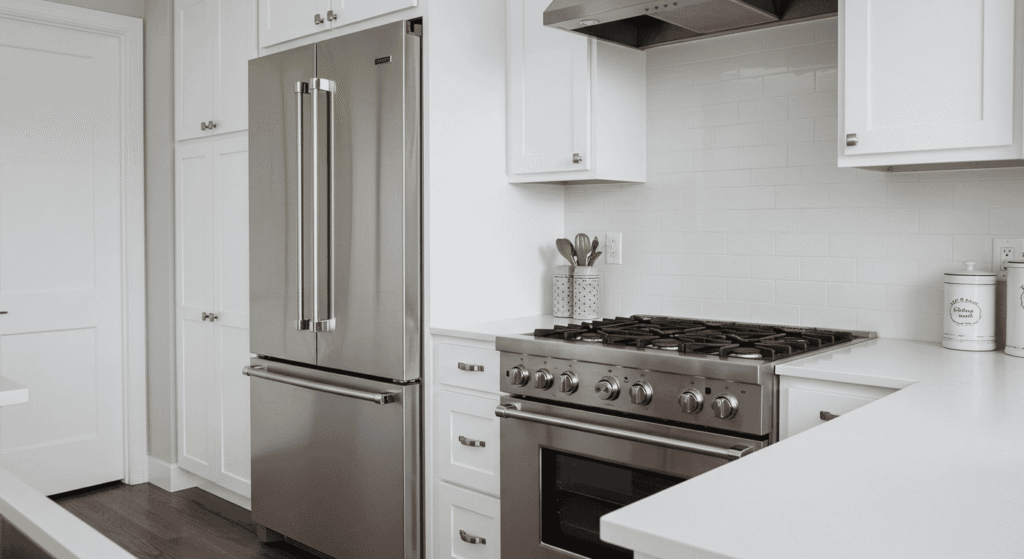
Using natural ingredients to clean and polish your stainless steel appliances is not only safe but also budget-friendly. These easy DIY recipes harness everyday household items to keep your appliances looking spotless and shiny.
Homemade Stainless Steel Cleaner Recipe #1: Vinegar and Water Spray
This simple spray is perfect for removing fingerprints and light smudges:
- Mix equal parts white vinegar and water in a spray bottle.
- Lightly mist the surface of your appliance.
- Wipe with a clean microfiber cloth following the grain of the steel.
- For best results, dry the surface immediately to avoid streaks.
Recipe #2: Baking Soda Paste for Tough Spots
For stubborn stains or grease buildup, try this gentle scrubbing paste:
- Combine baking soda with a small amount of water to form a thick paste.
- Apply the paste to the affected area using a soft cloth or sponge.
- Gently rub in circular motions, avoiding harsh scrubbing that could scratch.
- Rinse with a damp cloth and dry thoroughly.
Polishing Mixture: Olive Oil and Lemon Juice Blend
Restore shine and add a protective finish with this natural polish:
- Mix 2 tablespoons of olive oil with 1 teaspoon of fresh lemon juice.
- Apply a small amount of the mixture to a soft cloth.
- Buff your appliance surface in the direction of the grain until it gleams.
- This blend nourishes the metal while leaving a fresh scent behind.
These DIY cleaners are effective and gentle alternatives to commercial products, helping you maintain your stainless steel appliances naturally and beautifully.
Avoid These Common Mistakes When Cleaning Stainless Steel
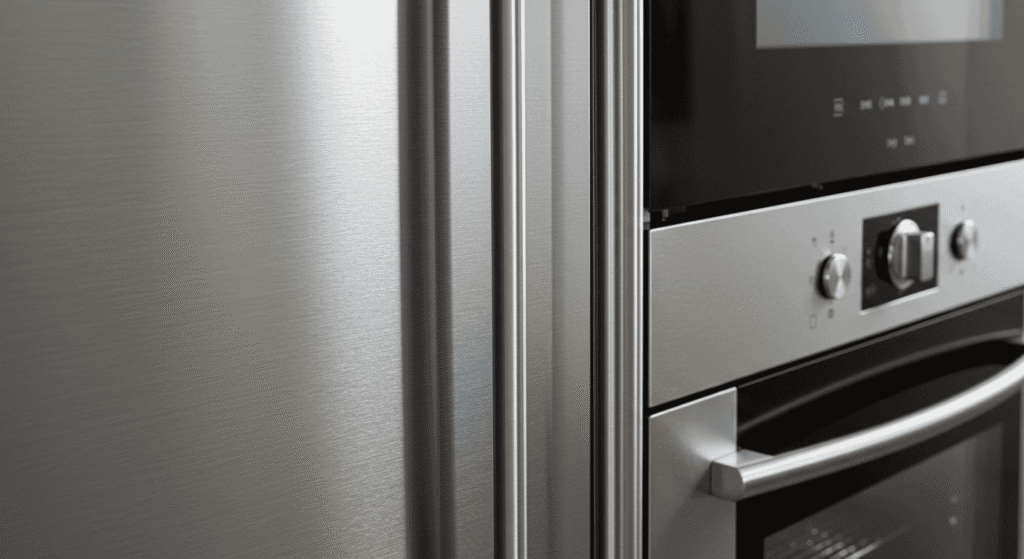
Proper cleaning techniques are essential to maintain the beauty and integrity of your stainless steel appliances. Avoiding these common mistakes will help prevent damage and keep your appliances looking their best for years to come.
Using Abrasive Tools That Scratch the Surface
Many people assume that rough scrubbers or steel wool clean better, but these abrasive tools can leave permanent scratches on your stainless steel. These scratches not only ruin the smooth finish but also create places for dirt and rust to accumulate. Always opt for soft microfiber cloths or non-abrasive sponges designed specifically for delicate surfaces.
Applying Harsh Chemicals That Cause Discoloration
Using harsh chemical cleaners might seem like a quick solution for tough stains, but these products can cause discoloration or corrosion on your stainless steel appliances. Chemicals with bleach, ammonia, or chlorine can damage the protective layer of stainless steel, leading to dull spots or even rust. Instead, stick to gentle, natural cleaning solutions that protect the surface while effectively removing grime.
Not Following the Grain Direction When Wiping
The grain of stainless steel is more than just a visual pattern—it’s the structure of the metal surface. Wiping against the grain can cause visible streaks and micro-scratches, making your appliances look dull or worn. Always wipe and polish in the direction of the grain for the best results and a streak-free shine.
Table: Mistakes vs. Consequences
| Mistake | Why It Happens | Result on Appliance | How to Avoid |
|---|---|---|---|
| Using steel wool or rough scrubbers | Thinking it cleans better | Scratches and dull finish | Use microfiber cloths |
| Harsh chemical cleaners | Trying quick fixes | Discoloration, damage | Stick to gentle natural cleaners |
| Wiping randomly | Ignorance of stainless grain | Visible streaks | Always wipe with the grain |
Understanding these common pitfalls will help you avoid costly damage and keep your stainless steel appliances looking polished and pristine.
How to Maintain Your Stainless Steel Appliances Between Deep Cleanings
Regular maintenance is key to keeping your stainless steel appliances looking their best without the need for frequent deep cleans. Simple habits can prevent buildup and extend the life of your appliances.
Daily Wiping Routine with Microfiber Cloth
Incorporate a quick daily wipe-down using a clean, dry microfiber cloth. This helps remove dust, fingerprints, and light smudges before they become stubborn stains. Because microfiber traps dirt and oils without scratching, it’s the safest tool for everyday use. Make it a habit to wipe in the direction of the grain for a consistent, streak-free look.
Quick Spot Cleaning Tips for Fingerprints
Fingerprints are one of the most common issues with stainless steel appliances. For quick fixes, lightly dampen a microfiber cloth with a mixture of water and white vinegar or simply use a damp cloth followed by drying. This removes oils and dirt effectively without leaving streaks. For high-touch areas like fridge handles or oven doors, spot cleaning multiple times a day can keep surfaces fresh and shiny.
Preventing Rust and Damage with Proper Use
Rust and damage often result from moisture buildup or scratches. To prevent this, wipe away spills immediately, especially acidic substances like lemon juice or tomato sauce. Avoid using abrasive cleaners or tools that can wear down the protective stainless steel layer. Additionally, keep appliances dry after cleaning and consider occasional polishing with a natural oil like olive oil to create a water-resistant barrier that repels dirt and fingerprints.
Troubleshooting: How to Handle Tough Stains and Rust Spots
Even with regular care, your stainless steel appliances can sometimes develop stubborn stains or rust spots. Knowing how to identify and treat these issues will help restore your appliances’ appearance and prevent further damage.
Identifying Different Types of Stains
Not all stains on stainless steel appliances are the same. Common types include:
- Rust spots: Often reddish or brownish, caused by prolonged moisture exposure or scratches.
- Hard water marks: White or chalky deposits from mineral buildup.
- Grease and food stains: Oily or sticky residues from cooking spills.
Recognizing the stain type is the first step toward effective treatment.
Homemade Remedies for Rust and Hard Water Marks
Natural solutions can tackle tough stains without harsh chemicals:
- For rust spots, gently apply a paste made from baking soda and water. Let it sit for 10-15 minutes, then rub softly with a microfiber cloth and rinse well.
- To remove hard water marks, spray diluted white vinegar (1:1 with water) on the affected area. Let it sit briefly, then wipe clean following the grain.
- Always dry the area thoroughly after treatment to prevent recurrence.
When to Seek Professional Help
If rust spots are widespread, deep, or the appliance surface appears damaged beyond cleaning, it may be time to consult a professional. Professionals can assess whether refinishing or repair is necessary to restore the appliance without causing further harm.
Summary Table: Best Cleaning Method for Different Stainless Steel Appliances
Maintaining your stainless steel appliances is easier when you use the right cleaning methods tailored to each appliance type. The table below summarizes the best approaches, polishing tips, and cleaning frequency to keep every appliance looking its best.
| Appliance Type | Recommended Cleaning Method | Polishing Tips | Frequency |
|---|---|---|---|
| Refrigerator | Vinegar spray + microfiber cloth | Olive oil buff once a month | Weekly wipe-down |
| Oven and Stove | Baking soda paste for grease stains | Lemon-olive oil polish weekly | Bi-weekly deep clean |
| Dishwasher Front Panel | Mild dish soap + water | Microfiber dry wipe | Weekly |
| Microwave Exterior | Vinegar-water solution | Gentle buffing with cloth | Weekly |
This quick reference helps you maintain each appliance properly, ensuring a streak-free, long-lasting shine without damaging the surface.
Keep Your Clean Stainless Steel Appliances Looking Like New
Maintaining clean stainless steel appliances doesn’t have to be difficult or time-consuming. With the right tools, natural cleaning methods, and simple routines, you can preserve their sleek appearance and extend their lifespan. Avoid common mistakes, address tough stains promptly, and follow regular maintenance tips to enjoy a spotless, shiny kitchen that feels fresh and inviting every day. Your appliances will thank you with lasting beauty and performance.






